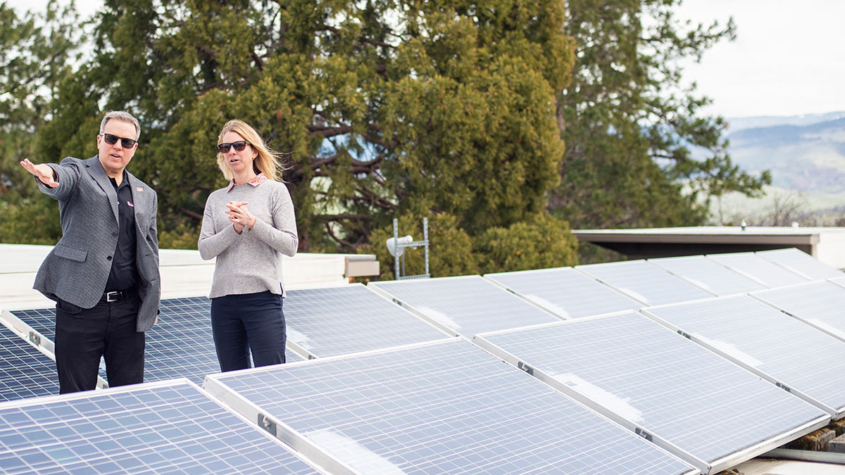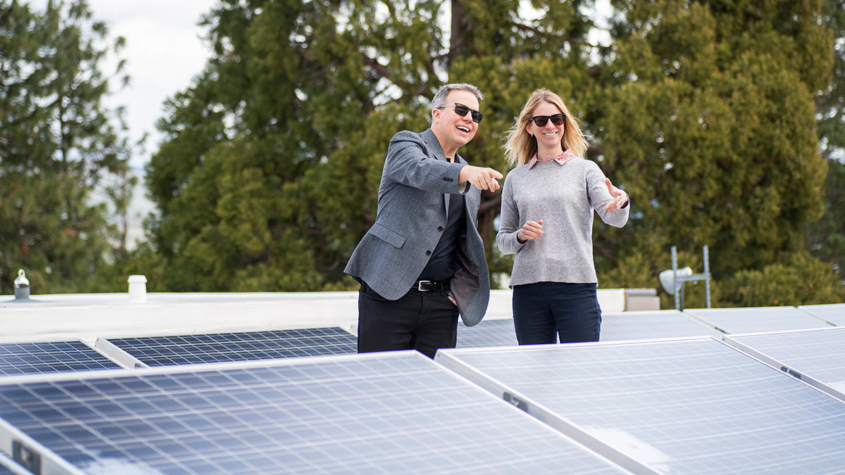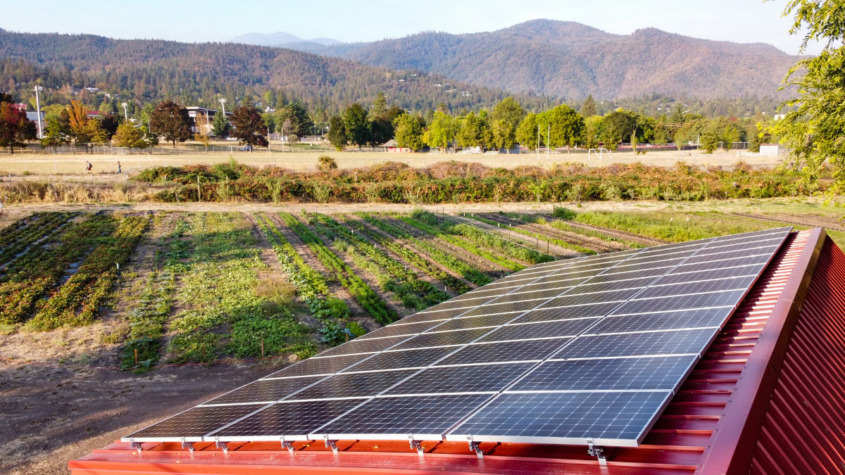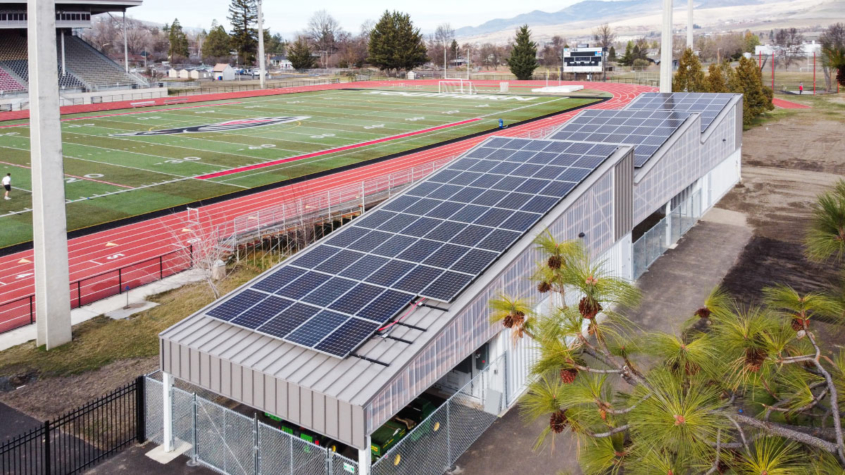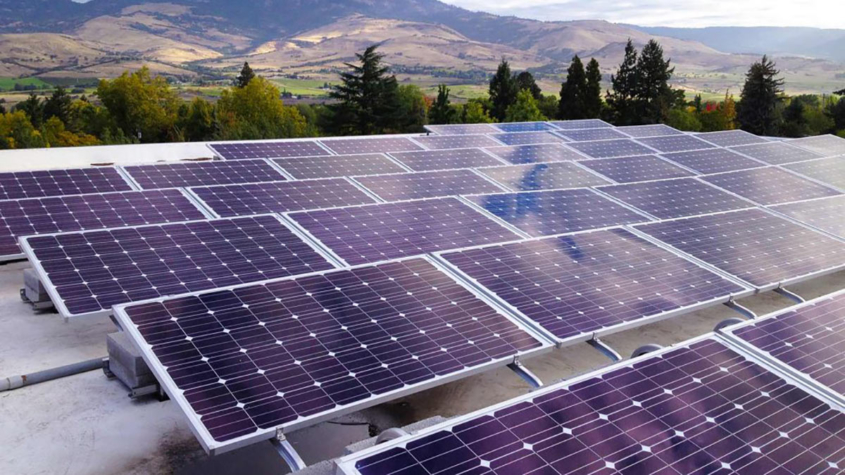New solar arrays move SOU toward energy self-sufficiency
(Ashland, Ore.) — Southern Oregon University is taking big strides toward becoming the first public university in the U.S. to produce all of the daytime electricity used on its campus, with a $1.56 million contract signed this month to install new solar arrays and a battery storage facility, and on-site construction work set to begin this winter.
The new installations on Lithia Motors Pavilion and The Hawk Dining Commons will increase SOU’s photovoltaic output by 86 percent – from the current 455 kilowatts to a total of 848 kilowatts.
The two new solar facilities, combined with nine existing arrays, will enable the university to generate just over 12 percent of the electricity it uses. The contract with Ashland’s True South Solar also includes a battery storage bank that will be built adjacent to The Hawk, enabling SOU to support community resilience by providing power in The Hawk, if needed, in the event of an emergency.
“This is truly a monumental step toward our goal of energy self-sufficiency,” SOU President Rick Bailey said. “We have spent much of the past year working with state and federal lawmakers to identify and secure funding for these projects – and that work will continue. But now we will begin to enjoy some of the fruits of our labors.
“These projects not only demonstrate our commitment to sustainability, but our eventual energy independence will save us at least $750,000 per year in utility costs. Each new array that we bring online will immediately start reducing that overall energy bill.”
The university anticipates generating 100 percent of its own electricity by 2033, and is already planning subsequent rounds of solar expansion. Another project whose contract has not yet been awarded – the first of several SOU arrays that will be built on parking lot structures – will add 340 kilowatts of generating capacity and bring the university to nearly 17 percent of its overall electricity usage.
SOU has been awarded $1 million in each of the past two years from the Oregon Department of Energy’s Community Renewable Energy Grant Program and received a $2 million appropriation from Congress last December. That total of $4 million in state and federal funding will pay for the lion’s share of work under the current contract, and for the initial parking lot array. The Student “Green Tag Fee” – an assessment of $14 per student each term, approved in a student vote several years ago – is also contributing $51,000 toward the cost of the current project, demonstrating student support for SOU’s generation of renewable energy.
“The campus-wide support for sustainability initiatives – in particular, our conversion to solar power – has been overwhelming,” SOU Sustainability Director Becs Walker said. “Students, faculty and staff are helping in whatever ways they can as we ramp up our efforts and transition to renewable energy.
“This entire process is valuable, with many learning opportunities for those who choose to become directly involved.”
True South Solar and its subcontractor, Welburn Electric of Phoenix, began design work for the current phase of solar expansion immediately after the contract with SOU was signed on Sept. 1. Drawings, specifications and permit work will take a couple of months, and orders for solar and battery storage equipment will extend into the winter months before site work begins.
The Lithia Motors Pavilion solar array is expected to be completed in early 2024, and the more-complex solar array and battery storage project at The Hawk Dining Commons is scheduled for completion by the fall of 2024.
Solar energy production is one of the initiatives that SOU is currently pursuing in its effort to be more entrepreneurial in its approach to revenue generation. Achieving the energy-independence goal will also contribute to a reduction in SOU’s greenhouse gas emissions.
SOU currently has nine solar arrays on campus, plus an array at the Higher Education Center in Medford and a pole-mounted array installed last year by a nonprofit on land leased from the university. SOU has added five arrays over the past three years, with funding by private investors, grants, the student government and university administration.
SOU will continue to implement energy conservation and energy efficiency measures as it increases its solar power production. For instance, The Hawk Dining Commons and McLoughlin Residence Hall each have solar hot water systems installed to augment their natural gas domestic water heating, and the campus has three net-zero buildings – they create as much or more energy than they use.
The university is also a partner in the U.S. Department of Energy’s Better Climate Challenge, which supports SOU’s 2033 goals to reduce Scope 1 and Scope 2 greenhouse gas emissions by 50 percent from a 2018 baseline, and to reduce energy intensity by 25 percent from a 2022 baseline.
-SOU-
About Southern Oregon University
Southern Oregon University is a medium-sized campus that provides comprehensive educational opportunities with a strong focus on student success and intellectual creativity. Located in vibrant Ashland, Oregon, SOU remains committed to diversity and inclusion for all students on its environmentally sustainable campus. Connected learning programs taught by a host of exceptional faculty provide quality, innovative experiences for students. Visit sou.edu.

